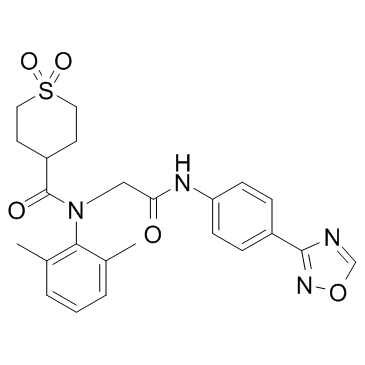| Description |
Amenamevir is a helicase-primase inhibitor which has potent antiviral activity against HSVs with an EC50 of 14 ng/mL.
|
| Related Catalog |
|
| Target |
EC50: 14 ng/mL (HSV)[1]
|
| In Vitro |
Amenamevir (ASP2151) inhibits the replication of the HSV strains isolated in Japan and the United States as well as the laboratory-stocked strains. The mean EC50s of Amenamevir against HSV-1 and HSV-2 are 14 (range, 7.7 to 20) and 30 ng/mL (range, 15 to 58), respectively, whereas those of acyclovir (ACV) are 29 (range, 18 to 38) and 71 ng/mL (range, 45 to 95), respectively. The EC50s of Amenamevir against HSV strains are significantly lower than those of ACV[1].
|
| In Vivo |
Amenamevir (ASP2151) administration accelerates the reduction in virus titer in a dose-dependent manner in the range of 3 to 30 mg/kg/day. Amenamevir treatment decreases both lesion scores and HSV-1 titers in a dose-dependent manner, irrespective of the dosing interval. Based on the correlation curves, the PK parameters at which HSV-1 growth is completely suppressed by oral administration of Amenamevir are estimated to be 10,000 ng/mL or higher for the maximum concentration of drug in serum (Cmax), 60 μg • h/ml or higher for concentration-time curve over 24 h (AUC24h), and 21 to 24 h for T>100 . The mean concentration of Amenamevir in plasma at 5 days postinfection increases in a dose-dependent manner, with doses of 3 mg Amenamevir/g or higher significantly reducing the intradermal HSV-1 titer[1].
|
| Cell Assay |
The antiviral activities of Amenamevir (ASP2151) and ACV against HSVs are tested using a plaque reduction assay. Briefly, HEF cells are seeded into multi well plates and incubated until they form a monolayer. After the medium is removed, the cells are infected with HSV-1 or HSV-2, and the plates are further incubated for 1 h at 37°C. The cells are washed twice with maintenance medium and then treated with the test compound (including Amenamevir) until clear plaques appear. The cells are then fixed with 10% formalin in phosphate-buffered saline, stained with a 0.02% crystal violet solution, and the number of plaques is determined under a light microscope. The EC50, which represents the concentration of test compound needed to reduce the plaque number by 50%, is calculated using nonlinear regression analysis with a sigmoid-maximum effect (Emax) model[1].
|
| Animal Admin |
Female hairless mice (HOS:HR-1, 7 to 8 weeks old) are infected with a suspension of HSV-1 strain WT51 (15 μL/mouse; titer, 2×108 PFU/mL) or CI-116 (15 μL/mouse; titer, 4×107 PFU/mL) in the dorsolateral skin stripped as a small square using a needle, under anesthesia. The day of HSV-1 infection is designated day zero postinfection. Total daily doses of 1, 3, 10, 30, or 100 mg/kg/day ASP2151 are orally administered to HSV-1-infected mice (n=5) for 5 days. Amenamevir (ASP2151) treatments are started 2 to 3 h after HSV infection either as a single daily dose (every 24 h, q24h) or as two (every 12 h, q12h) or three (every 8 h, q8h) divided doses. Lesion scores and intradermal HSV-1 titers are measured on day 5 postinfection[1].
|
| References |
[1]. Katsumata K, et al. Pharmacokinetics and pharmacodynamics of ASP2151, a helicase-primase inhibitor, in a murine model of herpes simplex virus infection. Antimicrob Agents Chemother. 2013 Mar;57(3):1339-46.
|
